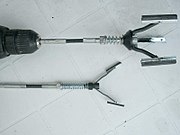Hi
shedhead. The hardest thing for a beginner to do is try to shape the tip of a gouge, considering that when you buy the majority of gouges they are definitely not the shape you want.
A easy tip on how to initially pre-shape your new or disfigured end before sharpening, is to have a guide line of the to shape to grind to.
What you do is set the gouge FLUTE DOWN on a flat grinding table angled against the stone so it will grind to the approximate length you want your swept back wings to be. This is done by guess work looking at it from the side, you decide the length of wings. You don't need them too long.
Switch on and keeping the flute hard on the table gently grind the corners of the wings back at this angle. Keep checking during the grinding, you should see a small flat appearing on each wing top. Stop grinding once the flats JUST reach the tip of the flute. Don't over grind, if you grind the tip you will just have to grind more metal away and waste your chisel.
What you should have now is two flats on the tops of each wing, and looking down at the inside edges you will see the shape of the tip you intend grinding up to. This is your grinding line.
Fit the chisel into your sharpening jig, and only grind away the sides of the flats. You can work on one side at a time, or both, you choose. What you are doing is grinding all the steel away and following the shape you made with the flats, leaving the inside edge of the flats as your cutting edge. Once you have the sides reasonable you can then begin grinding all around the edge VERY GENTLY. Continue until you have a consistent edge around the tool tip. DO NOT grind over the inside line of the flats otherwise you WILL get a pointed tip.
You should only ever have to do this once with each gouge, because you are going to set up your jig to the same angle every time you wish to re-sharpen. Also when you sharpen you DO NOT grind, you only just lightly stroke the edge of the tool on the stone and you are back to work. You must continue to follow the original shape you began with or you'll be back to your pointed end, so double check the settings of the jig before even touching the wheel.
One thing I really dislike about most of the sharpening jigs on the market, there are just too many variables for people to work with. If you have a rigid jig it takes a lot of the variable angles out of the task.
Good luck, and let me know how you get on.






